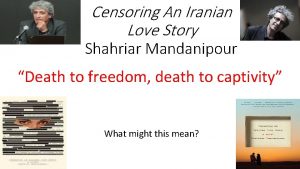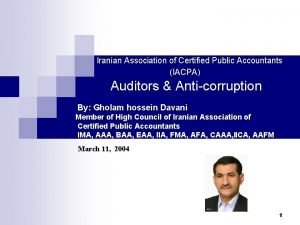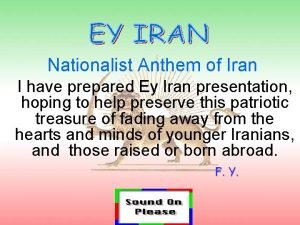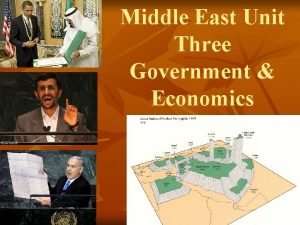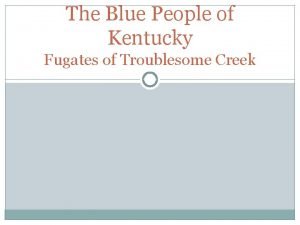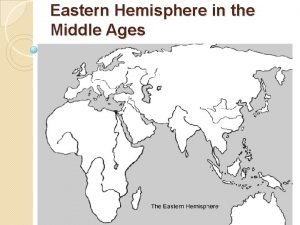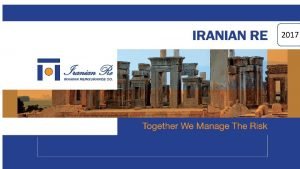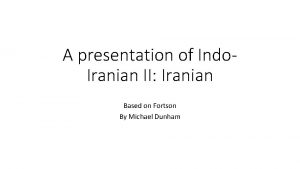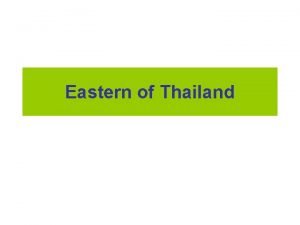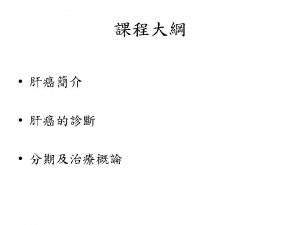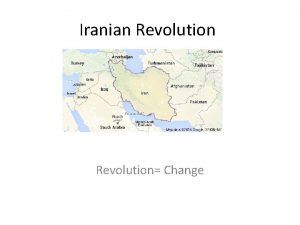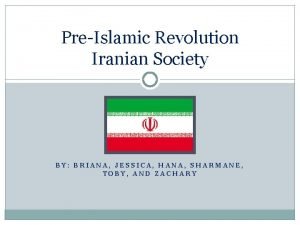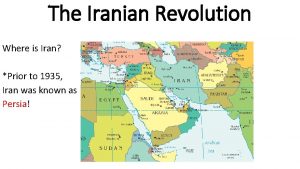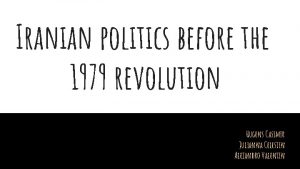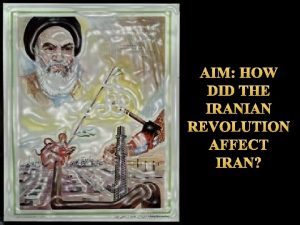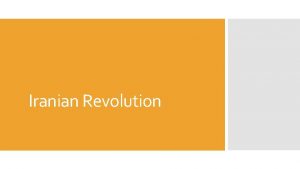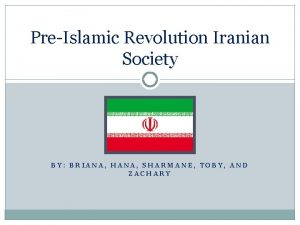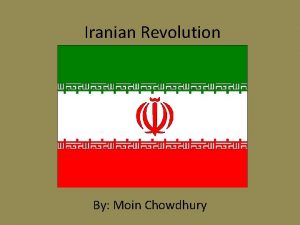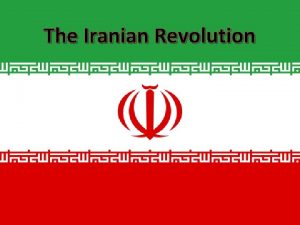th 20 Century middle Eastern Issues Iranian Revolution


























- Slides: 26

th 20 Century middle Eastern Issues

Iranian Revolution

Iranian Revolution Lib. utexas. edu 2004

Iranian Revolution CIA. gov

Iranian Revolution CIA. gov

Iranian Revolution Background -Shah Mohammed Reza Pahlavi (1919 -1980) supported and put in power by the CIA in 1953 -Why? What was happening in 1953? Cold War

Iranian Revolution Muhammad Musaddiq Opposed Reza Pahlavi and wants to end Britain’s control of Iran’s oil. He was ousted in 1953. Ibtauris. com

Iranian Revolution Mohammed Reza Shah Pahlavi (1919 -1980) Why was he so disliked? Between 1953 and 1963 poverty remained among the Iranian people the gap between the rich and poor grew. Iran was an oligarchy of one thousand families. One of the great landowners was the Shah (king), Muhammad Reza Pahlavi. Secularism increased and the power and influence of Shia scholars decreased. The Shah allied himself with secularists in conflict with Muslims who held traditionalist values on such matters as tobacco, alcohol, movies, gambling and foreign dress. Pahlavi. org

Iranian Revolution Globalsecurity. org Ayatollah Ruhollah Khomeini (1900 -1989) Why was he so influential? -learned Shiite legal expert -Against American influences. He bans music, movies and women’s rights while in power. -Sets up a theocracy or rule by religion. -Muslims become skeptical about Western models of economic development

Iranian Revolution Fedaiyan-e Islam Some discontented Muslims formed an underground group called the Fedaiyan-e Islam. They tried to assassinate the Shah's prime minister. The Shah responded by repressing the Fedaiyan-e Islam and executing a few of its members.

Iranian Revolution March 22, 1963 The Shah launched an effort to modernize Iran economically and socially. He sought to balance his increase in power with reforms that would win more favor from common Iranians. The Shah announced that his reforms would take Iran into the jet age while the mullahs wanted to remain "in the age of the donkies. ” In the holy city of Qom, theological students who were agitating against a scheduled opening of liquor stores were attacked by the Shah's security agents – SAVAK. The disturbance spread to students in the city of Tabriz. There and in Qom, according to some, government forced killed hundreds.

Iranian Revolution SAVAK and Martial Law Ayatollah Khomeini was arrested on June 5, 1963 which caused anti-government demonstrations and rioting in a variety of cities. The Shah declared martial law. Khomeini went into exile, Khomeini settled in a Shiite community in southern Iraq. From Iraq, Khomeini continued his attacks on the Shah, sending into Iran pamphlets and tape recordings.

Iranian Revolution Reform and Censorship Laws From 1963 and into the seventies, the Shah struggled to modernize Iran – with help from the U. S. , The Shah accepted Israel and foreign policy strategists saw him as a stabilizing force in the Middle East. With U. S. help, Iran laid plans for a proliferation of atomic power plants, and the new economic development included the introduction of new fertilizers and pesticides. Between 1963 and 1967 Iran's economy rose dramatically. Oil production boomed, producing an abundance of cash for Iran. Steel mills rose from 1, 902 in 1963 to 7, 989 in 1977. There were also new oil refineries, aluminum smelters, machine tool factories and new tractors, trucks and automobiles. Public education improved dramatically, as did public health services.

Iranian Revolution Reform and Censorship Laws Shah continued his repression against clerics hostile to his modernization. In 1966 he established book censorship, with police agents raiding mosque libraries. In 1967 new laws gave women the right to apply for divorce without the husband's permission, a man had to secure his wife's consent before taking a second wife, and legal matters involving families were transferred from religious to secular courts.

Iranian Revolution Ayatollah Ruhollah Khomeini (1900 -1989) How does he gain power? -Reza Pahlavi bans Khomeini in 1962 -Khomeini stays in An Najaf in Iraq for fifteen years. -He is expelled in 1977 because he is a Shi’ite. -Shah Reza Pahlavi relaxes censorship laws in 1977, the writings of Khomeini begin to circulate. -January 9, 1978, students protest the visit by President Jimmy Carter, strikes ensue -Shah steps down on January 16, 1979.

Iranian Revolution President Carter In 1977, Jimmy Carter became President and put human rights into his foreign policy agenda. The Carter administration suggested that if Iran did not improve its human rights record, aid, including military assistance, might be terminated. Scu. edu

Iranian Revolution Iran Timeline June 6, 1963 Martial law ordered as riots follow the arrest of Ayatollah Khomeini. January 16, 1979 Shah leaves the country after turmoil and heads to Egypt. February 1, 1979 Revolutionary forces under Khomeini seize power after his return to the country (He had gone into exile after arrest in 1963). March 31, 1979 Referendum approved the establishment of an Islamic republic with Khomeini in de facto control. April 7, 1979 Prominent Iranians executed. Nov. 4, 1979 Iranian militants seized the U. S. embassy in Teheran and held sixty six occupants hostage, demanding the return of the shah from the U. S. After the shah's death in 1980 in Egypt, an agreement was negotiated that freed the hostages on 20 January 1981. December 2, 1979 Khomeini became absolute ruler for life. July 27, 1980 The Shah dies November 1980 The First Gulf War broke out between Iran and Iraq.

Iranian Revolution http: //www. youtube. com/watch? v=k. Y 0 ix. G 94 c. HE

Iranian Revolution http: //www. iranchamber. com/history/islamic_revolution/i slamic_revolution. php

Iranian Revolution BBC http: //news. bbc. co. uk/2/shared/spl/hi/pop_ups/04/middle_east_th e_iranian_revolution/html/1. stm

Iranian Revolution U. S. Hostages Students seized the U. S. embassy on November 4, 1979. Khomeini wavered at first but then gave the students his support. Khomeini called the United States the "Great Satan" and the U. S. embassy a "den of spies. " Prime Minister Bazargan and his cabinet resigned on the 6 th following the hostage taking. Iran expected U. S. deliver to Iran the Shah as an exchange for freeing the hostages.

Iranian Revolution History of Iran https: //www. youtube. com/watch? v=Q_AHJQi. Mx. Iw

Iranian Revolution Iraq War (1980 -1988) Causes Iraq feared that Iran's new revolutionary leadership would threaten Iraq's delicate Sunni -Shia balance and would exploit Iraq's geostrategic vulnerabilities Iraq claimed territories inhabited by Arabs (the Southwestern oil-producing province of Iran called Khouzestan) Iraq's right over Shatt el-Arab waterway (Arvandroud). Iraq claimed the 200 -kilometer channel up to the Iranian shore as its territory, while Iran insisted that the thalweg--a line running down the middle of the waterway--negotiated last in 1975, was the official border. http: //www. globalsecurity. org/military/world/war/iran-iraq. htm

Iranian Revolution Iraq War (1980 -1988) Causes Iranian-supported Ad Dawah attempted to assassinate Iraqi foreign minister Tariq Aziz. Shortly after the failed grenade attack on Tariq Aziz, Ad Dawah was suspected of attempting to assassinate another Iraqi leader, Minister of Culture and Information Latif Nayyif Jasim. In the summer of 1980, Saddam Hussein ordered the executions of presumed Ad Dawah leader Ayatollah Sayyid Muhammad Baqr as Sadr and his sister. A few weeks later, Saddam Hussein officially abrogated the 1975 treaty between Iraq and Iran and announced that the Shatt al Arab was returning to Iraqi sovereignty. http: //www. globalsecurity. org/military/world/war/iran-iraq. htm

Iranian Revolution Iraq War (1980 -1988) Results Four major battles were fought from April to August 1988, in which the Iraqis routed or defeated the Iranians. Farther to the north, in the last major engagement before the August 1988 cease-fire, Iraqi armored and mechanized forces penetrated deep into Iran, defeating Iranian forces and capturing huge amounts of armor and artillery. In the fall of 1988, the Iraqis displayed in Baghdad captured Iranian weapons amounting to more than three-quarters of the Iranian armor inventory and almost half of its artillery pieces and armored personnel carriers. The Iran-Iraq war lasted nearly eight years, from September of 1980 until August of 1988. It ended when Iran accepted United Nations (UN) Security Council Resolution 598, leading to a 20 August 1988 cease-fire. http: //www. globalsecurity. org/military/world/war/iran-iraq. htm

Iranian Revolution
 Iranian revolution timeline
Iranian revolution timeline Censoring an iranian love story
Censoring an iranian love story Iranian coup apush
Iranian coup apush حسابدار رسمی
حسابدار رسمی Ey iran national anthem
Ey iran national anthem Indo iranian languages
Indo iranian languages Aerophone
Aerophone Ocw
Ocw Map of middle east
Map of middle east Middle east map
Middle east map Russian revolution vs french revolution
Russian revolution vs french revolution How could the french revolution been avoided
How could the french revolution been avoided Third agricultural revolution
Third agricultural revolution Kwakiutl food
Kwakiutl food Italian cdm
Italian cdm Community care plan of eastern carolina
Community care plan of eastern carolina Blue people silver
Blue people silver Eastern regional high school grading scale
Eastern regional high school grading scale Southern and eastern asia physical features answer key
Southern and eastern asia physical features answer key Eastern woodland location
Eastern woodland location The gray-eyed morn smiles on the frowning night
The gray-eyed morn smiles on the frowning night Eastern hemisphere
Eastern hemisphere Secneer
Secneer Southern and eastern asia physical features answer key
Southern and eastern asia physical features answer key Eastern home shopping & leisure co., ltd.
Eastern home shopping & leisure co., ltd. Chapter 16 eastern mediterranean answers
Chapter 16 eastern mediterranean answers Eastern beliefs • buddhism hinduism confucianism *
Eastern beliefs • buddhism hinduism confucianism *

